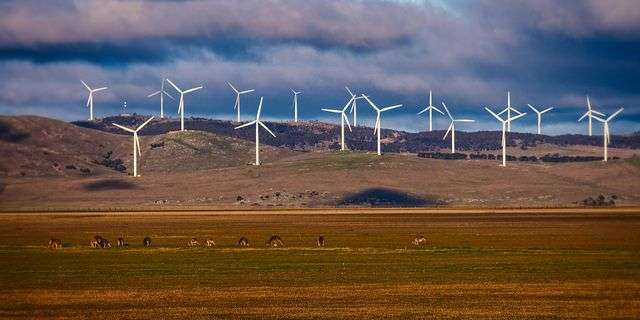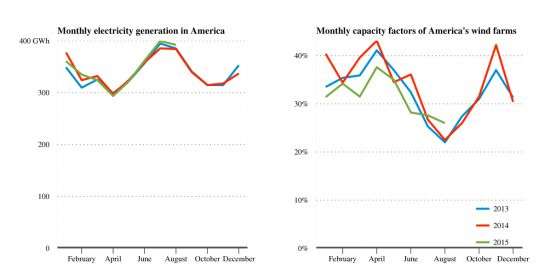Wind farms—why their carbon footprints matter as much as their locations

Seasonal and daily patterns of electricity consumption follow almost identical forms everywhere. Demand is low in the middle of the night when the bulk of humanity is sleeping and it peaks either in the middle of the day when we switch on our air conditions or at night when we turn on our lights.
These patterns are consistent and predictable. And until now this demand has been t by fossil fuel and nuclear power plants that can be ramped up and down to meet the electricity requirements of modern economies.
But today a new future is emerging, or is promised. Many countries, from Germany to Denmark, have pledged to run their electricity grids almost entirely from renewable sources.
In countries close to the equator this will most likely be achieved through solar power. But anyone familiar with winter – or even summer – evenings in northern Europe will realize that Germany, Britain or anywhere else will not be running on solar panels any time soon.
Instead, they will have to rely heavily on the wind.
The fundamental questions that arise about the future of wind energy concern space and geography. First, how much space we are willing to have occupied by wind farms and where do we put them?
The challenges can be illustrated by a simple calculation. The London Array wind farm will provide approximately 0.6% of Britain's electricity demand. This will be achieved by covering 100 square kilometres of the English coast with 175 skyscraper sized turbines. But what if Britain was to scale up its wind power to meet actual demand? Getting close to 100% wind electricity would require an area the size of Wales to be covered in turbines. This is not likely to be politically or socially acceptable.
Related questions concern how windy a specific site is and how easily it can be connected to the grid.
However, as recent studies, including two recently added to the PLOS Responding to Climate Change Collection, help demonstrate,the true potential of wind energy as a fossil fuel alternative is dependent on a number of factors, not simply the cost of erecting wind turbines and finding places to put them. Such research is pointing to new considerations; for example, although seasonal wind patterns fluctuate regionally, viewing such fluctuations on a continent-wide basis may help address demand issues, while a wind turbine in one location may be more effective at reducing carbon dioxide emissions than one in a windier location.
Wind farms can be most productive when we least need electricity

Preferably, the daily and seasonally pattern of wind farm production is as close as possible to that of electricity demand. The more different they are, the more wind electricity will have to be curtailed when wind farm production exceeds the demand for electricity.
Throughout most of the world, the seasonal pattern of wind farm output is similar. Wind speeds are highest in winter and lowest in summer. This is true in all European countries and most of North America.
It is also true in China, where half of the growth in world electricity demand occurred this century. The bulk of China's population, and thus its electricity consumption, are located in its densely populated coast provinces. Recent work by Gao et al. (2015) in PLOS ONE calculated seasonal variations in wind speeds at locations along the Chinese coast, including regions nearing the rapidly growing Pearl River Delta, north to Shanghai and close to Beijing.
Using long term time series of wind speeds at 12 evenly spaced locations along the Chinese coast, Gao et al recreated the expected annual cycle of monthly mean wind speed, and thus wind power. At all locations, wind power varies by at least a factor of two throughout the year, with the peak occurring in winter, but the low in summer. The low output of China's wind farms in summer is problematic for a simple reason: this is when electricity demand peaks.
This can be illustrated more clearly for America, where the Energy Information Agency (EIA) maintains reliable records of monthly capacity factors of wind farms and of electricity generation. The capacity factor of a wind farm is the average output of a wind farm divided by its maximum output, and monthly variations are therefore an excellent guide to seasonal changes in wind farm output.
In America wind farm capacity factors peak in winter and spring at over 40%. In contrast, electricity demand peaks in July and August. However, this is the time of the year when wind farm output is at its lowest. In fact, in both 2013 and 2014 wind farm output in August was 33% lower than it is on average throughout the years.
Why wind farms should not just be judged on their output alone
These fluctuations can potentially be flattened out by taking a more integrated continent-wide approach to renewable energy. While the average American wind farm is least productive in August, this is not true everywhere. California's wind farm output peaks in summer, and therefore partly acts to flatten out continent wide seasonal fluctuations.
However, simply comparing wind energy output and demand is to take a too narrow approach. We are not simply building wind farms to provide electricity. We also have to consider when and where wind farms will reduce carbon dioxide emissions most effectively.
The carbon emissions saved by wind farms is not a simply function of how much electricity they generate, but are also strongly related to the other forms of generation on an electricity grid. The output of wind farms at a moment in time effectively displaces the marginal fuel on the grid. . Parts of America's electricity system are dominated by coal, others by natural gas. This is typically natural gas or coal, depending on the time of day or year. Wind farms are preferable in coal dominated systems because coal fired power plants are twice as carbon intensive as gas power plants.
As is shown by a recent study in PNAS, the quality of a location of a wind farm is therefore as much to do with the nature of a region's existing electricity as it is with wind speed.
The importance of the relationship between wind farms and existing renewables
These complexities are illustrated well by the relationship between wind power and hydroelectricity, the focus of a recent study of the Pacific Northwest by Cross et al. (2015) in PLOS ONE. Canada gets 62% of its electricity from hydroelectric dams. However, this high dependence on hydroelectricity has challenges. Output of hydroelectric dams is highly dependent on rainfall patterns. It is therefore ideal that wind farm output is highest when hydroelectric dams are running low on water. Furthermore, hydroelectric dams can act as a way of buffering the intermittency of wind farms. Each time it is windy you do not need to release water from a dam, which effectively as a form of energy storage.
This region gets approximately 70% of its electricity from hydroelectricity. Future increases in electricity consumption and the need to reduce carbon emissions mean that the region is expected to significantly increase its renewable energy production. However, this is likely to focus on wind power, because of a variety of constraints on hydroelectricity production.
One of the key things you want from a wind farm in this region is that it is at its most productive when hydroelectric dams are at their most empty. What Cross et al. found is that where you point a wind farm matters.
Using long-term time series of the water inflow of dams and wind speeds, they were able to compare the extent to which conditions for hydroelectric and wind farm output are related. Wind farm output on US coasts would be at their best when hydroelectric dams are also performing well, which is not ideal. In contrast, wind farms located along British Columbia's north coast are more likely to produce high amounts of electricity. More northern locations are therefore likely to be more desirable if the desire is to proper integrate wind farms and hydroelectric dams and reduce carbon emissions.
The location of wind farms therefore matters. Judging a wind farm simply by the price you have to pay for each unit of electricity is only part of the story. We must ask how much the wind blows, when the wind blows and how much carbon dioxide the wind farm will actually save. If we do this, we will have a more cost effective climate and energy policy.
Journal information: PLoS ONE , Proceedings of the National Academy of Sciences
Provided by Public Library of Science
This story is republished courtesy of PLOS Blogs: blogs.plos.org.




















